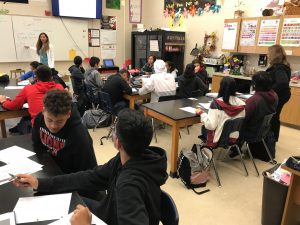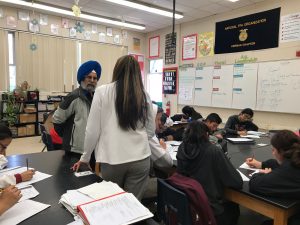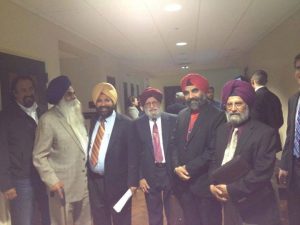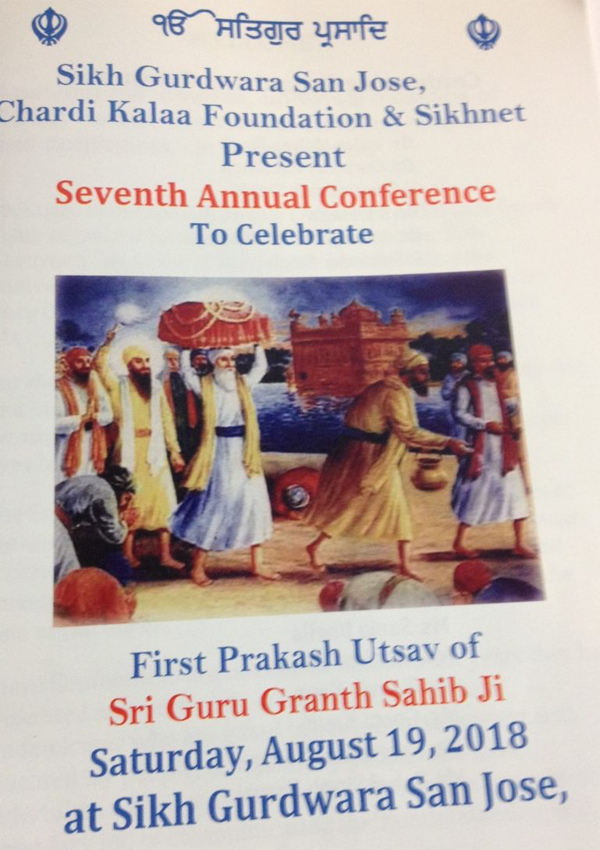ਜੇ ਤੁਹਾਨੂੰ ਸੰਸਾਰ ਦੀਆਂ ਸਾਰੀਆਂ ਭਾਸ਼ਾਵਾਂ ਆਉਂਦੀਆਂ ਹਨ ਅਤੇ ਤੁਹਾਨੂੰ ਆਪਣੀ ਮਾਂ ਬੋਲੀ ਜਾਂ ਆਪਣੇ ਸਭਿਆਚਾਰ ਦੀ ਭਾਸ਼ਾ ਨਹੀਂ ਆਉਂਦੀ ਤਾਂ ਇਸੇ ਨੂੰ ਗੁਲਾਮੀ ਕਹਿੰਦੇ ਹਨ! ਗੂਗੀ ਵਾ ਬਿਉਂਗੋ

Punjabi language- the mother tongue of Punjabis and the official language of the Land of Five Rivers apparently face a tough time in homes, schools and offices in Punjab. So much so some say, with good reasons; Punjabi language might disappear in the next 50 years!
Strange it may sound 10,000 Miles away in California, observing a Punjabi study class in session at a high School in the Central Valley namely: Kerman Unified School District pictured right hand side below here, tells a different story.
The Central Valley of California is well known as the adopted home for hard working and colorful Punjabis. What is less known perhaps is that it now welcomes its Punjabi language, culture and history to be included in the main stream education! It took a long time and lot of community effort, but the process to share our language, culture and history with our fellow Americans where it all begins for generations to come i.e. in the public school system is appealing and gaining momentum in the Central Valley public schools.
The Punjabi studies class at the Kerman High School was started a few years back thanks to the activism of the local community and some community leaders: Mohinder Singh Grewal and Jagjit Singh Thind who live in Kerman. Interestingly this English speaking nation sees its future in diversification and wants to prepare the younger generation by teaching more languages in addition to English. More languages learned more power to its citizens appears to be the undeclared motto.

Convincing people by persuasion than merely by force of law or by propaganda is the right thing to achieve lasting results, which is a slow process, needs vision and patience as it takes time. Not all school districts for instance immediately took advantage of the law in the books, where 15 or more students want to learn Punjabi or other language; a class can be started in the public schools!

Good news is that the Central Unified School Districts (CUSD) with an enrollment of more than 15,000 students has also started a Punjabi class this year. As the word spreads in the Central Valley, other school districts may also follow suit in the near future. Since Kerman Unified School District (KUSD) is way ahead in teaching Punjabi class, Robert Frausto Superintendent KUSD on our suggestion organized a Punjabi Course Observation and Meeting by inviting neighbor School District representatives on March 13, 2018. It was very thoughtful of him to share the experience with others and was very impressive to watch a diverse mixture of students learning side by side in the Punjabi class. There is a thing going round here that Mexican and other non-Punjabi origin students, sometimes top the Punjabi studies class.
Talking to the Central Unified School District authorities being central to the area, a similar Punjabi Course Observation and Meeting may be arranged at the CUSD next, by inviting all other neighboring school district representatives.

To arrive at this stage however, it took a long time and a lot of community effort that included national organizations namely: Sikh Coalition, Hindu Foundation of America and local organizations such as the Sikh Foundation of Palo Alto, Sikh Council of Central California, Punjabi American Heritage Society Yuba City as well as individuals especially Dr. Onkar Singh Bindra of Sacramento and many others. The problem was that for K12 education in public schools, the state had not updated History Social-Science content standards for more than two decades due to budgetary constraints. Consequently, numerous meetings took place at the Sacramento Capitol giving testimonies to the newly set up Curriculum Commission, State Board of Education (SBE), California Department of Education (CDE) as well as frequent meetings with Assembly members and Senators at the Capitol Sacramento 200 miles away to change all that. With the combined effort, the Senate Bill SB 1057 for updating the outdated content standards in K-12 education for many years, was passed in 2014. The Legislative digest of SB 1057 follows:
SB 1057, Corbett. Pupil curriculum: history-social science content standards.
Existing law required the State Board of Education, not later than November 1, 1998, to adopt statewide academically rigorous content standards in the core curriculum area of history-social science.
This bill would require the state board, on or before July 30, 2018, to adopt, reject, or modify history-social science content standards in accordance with specified procedures. The bill would require

the Superintendent of Public Instruction to convene a group of history-social science experts, as specified, and, with input from the group, would require the Superintendent, on or before March 30, 2018, to recommend history-social science content standards to the state board. The bill would require the Superintendent and the state board, by October 1, 2018, to report certain information on the implementation of those standards to the Governor and appropriate policy and fiscal committees of the Legislature. The bill would express legislative findings and declarations relating to history-social science content standards.

Supported by all communities and sponsored by the Hindu American Foundation (HAF), the SB 1057 sailed through the California State Senate with bipartisan support under the enthusiastic leadership of Senate Majority Leader Ellen M. Corbett (D-East Bay). Consequently, inclusion of Punjabi and Sikhism at K12 level along with other amendments was signed into a Law by Gov. Jerry Brown in 2014.
To conclude and in order to give readers some idea about teaching of Punjabi 1, 2 and 3 courses at Kerman Unified that meet the fine art graduation requirements and are at par with all foreign language classes may be described as follows:
Punjabi 1 (meets the California State University and University of California a-g requirement).
Prerequisite: none
This is a beginning course in Punjabi designed to provide the student with the basic skills of understanding, speaking, reading and writing the language. Oral communication skills are highly emphasized and various aspects of the Punjabi culture are covered.
Punjabi 2 (meets the CSU and UC a-g requirement).
Prerequisite: Must have passed Punjabi 1and /or teacher recommendation.
Punjabi 2 builds on the skills learned in Punjabi 1 and includes more advanced study of the Punjabi language, culture and history.The emphasis is placed on developing reading, writing, understanding and effective communication skills, with particular emphasis placed on oral use of the language, original composition, reading comprehension and Punjabi culture.
Punjabi 3 (meets the CSU and UC a-g requirement).
Prerequisite: Must have passed Punjabi 2 and /or teacher recommendation.
This course builds on the skills learned in Punjabi 2and includes more advanced study of Punjabi language and Punjabi culture. The emphasis is placed on developing reading, writing, understanding and effective communication skills, with particular emphasis placed on oral use of the language, original composition, reading comprehension and Punjabi culture.
Special Note:
Kerman Unified School District (KUSD) is now starting Punjabi 4 (Honors) class this year.
Like Kerman High School, Punjabi classes have also been available in Yuba City Unified School District in the north for the past some years. Modesto Unified School District had successfully introduced teaching “World Geography –World Religions which includes Sikhism as a grade 9 required course as an experiment 15 years ago, which was widely appreciated. Based on that Assembly Concurrent Resolution ACR 154 introduced by Assembly member Adam Gray – ACR 154 (Gray-2014) acknowledged and applauded the Modesto City School District’s initiative and achievements in teaching the unique World Geography- World Religions class and recommended that the class be considered for adoption by other school districts statewide.
In this changing scenario the next big challenge however is to teach the teachers and equip them with suitable teaching material. But it goes a long way to start fulfilling and enrich the educational necessity of a multicultural society, something for others to learn and the American nation to be proud of!

Leave a Reply